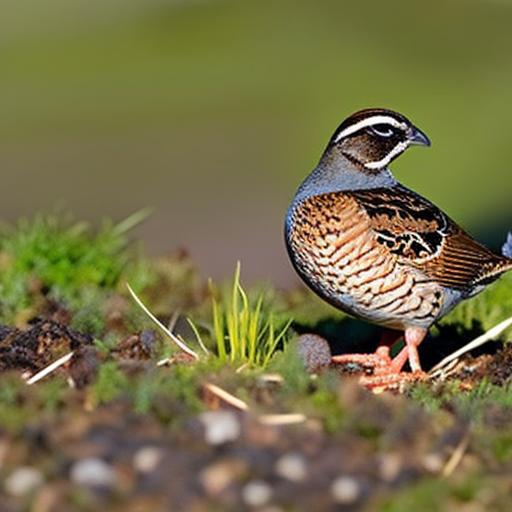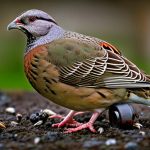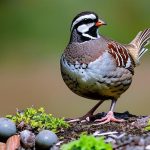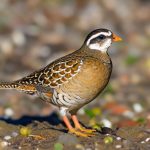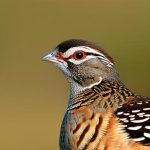Quail are small, ground-dwelling birds that are known for their elusive and skittish behavior. They are often found in rural and suburban areas, where they forage for food and seek shelter in dense vegetation. Quail are known to be active during the day, and they are particularly active during the early morning and late afternoon hours. They are social birds and often travel in small groups called coveys. Quail are also known for their ability to fly short distances, but they prefer to run and hide when they feel threatened.
Quail are primarily herbivores, feeding on a variety of seeds, grains, and small insects. They are also attracted to areas with dense vegetation and cover, as it provides them with protection from predators. Understanding the behavior of quail is essential when it comes to implementing effective strategies for managing their presence. By understanding their habits and preferences, it becomes easier to develop a plan that will deter them from unwanted areas without causing harm to the birds or the environment.
Key Takeaways
- Quail are ground-dwelling birds that are attracted to open areas with low vegetation and easy access to food and water.
- Physical barriers such as fences, netting, and covers can effectively prevent quail from entering specific areas.
- Natural deterrents like predator decoys, motion-activated sprinklers, and reflective objects can discourage quail from frequenting certain areas.
- Creating distractions such as bird feeders and designated feeding areas can divert quail away from sensitive areas.
- Removing food sources such as spilled birdseed and fallen fruits can help reduce the attractiveness of an area to quail.
- Seeking professional assistance from wildlife control experts can provide effective and humane solutions for managing quail behavior.
- Regular monitoring and maintenance of physical barriers, deterrents, and food sources is essential for long-term quail management.
Implementing Physical Barriers
One effective way to manage quail populations is by implementing physical barriers that prevent them from accessing certain areas. This can include the installation of fences, netting, or other structures that create a barrier between the quail and the desired area. Fences can be particularly effective in keeping quail out of gardens, agricultural fields, or other areas where they may cause damage. It’s important to ensure that any barriers are properly installed and maintained to prevent quail from finding ways to bypass them.
Netting can also be used to protect specific plants or crops from quail damage. By covering vulnerable areas with netting, it becomes much more difficult for quail to access the plants or crops, reducing the likelihood of damage. When implementing physical barriers, it’s important to consider the specific needs and behaviors of quail to ensure that the barriers are effective without causing harm to the birds or disrupting their natural behaviors.
Using Natural Deterrents
In addition to physical barriers, natural deterrents can also be effective in managing quail populations. One common natural deterrent is the use of predator decoys, such as fake owls or hawks, which can create the illusion of danger and discourage quail from entering certain areas. These decoys can be strategically placed in areas where quail are causing problems, such as gardens or agricultural fields, to deter them from foraging in those areas.
Another natural deterrent is the use of certain plants or herbs that are known to repel quail. For example, planting marigolds or garlic around vulnerable plants or crops can help deter quail from feeding on them. Additionally, certain scents, such as citrus or peppermint, can also be used to repel quail from specific areas. By using natural deterrents, it’s possible to manage quail populations without causing harm to the birds or the environment.
Creating Distractions
Creating distractions can also be an effective strategy for managing quail populations. By providing alternative food sources or habitats, it’s possible to redirect quail away from areas where they may cause damage. For example, planting cover crops or setting up feeding stations in less vulnerable areas can help draw quail away from gardens or agricultural fields. This not only helps protect vulnerable plants and crops but also provides a more sustainable solution for managing quail populations.
Another way to create distractions is by providing alternative habitats for quail to nest and roost. By setting up nesting boxes or providing suitable habitat in less vulnerable areas, it’s possible to encourage quail to establish themselves in areas where they are less likely to cause problems. Creating distractions is a proactive approach to managing quail populations that can help reduce conflicts between humans and wildlife.
Removing Food Sources
Quail are attracted to areas with abundant food sources, so removing or reducing these food sources can help deter them from unwanted areas. This can include practices such as removing spilled birdseed, securing garbage cans, and cleaning up fallen fruits or grains that may attract quail. By reducing the availability of food in certain areas, it becomes less attractive for quail to forage there, reducing the likelihood of conflicts with humans.
In agricultural settings, it’s important to manage crops in a way that reduces their attractiveness to quail. This can include practices such as timely harvesting, crop rotation, and using deterrent crops that are less appealing to quail. By managing food sources in agricultural settings, it’s possible to reduce the likelihood of damage caused by quail while promoting sustainable farming practices.
Seeking Professional Assistance

In some cases, managing quail populations may require professional assistance from wildlife management experts or pest control professionals. These professionals have the knowledge and experience to develop and implement effective strategies for managing quail populations while minimizing harm to the birds and the environment. They can provide valuable insights and recommendations based on the specific needs and challenges of each situation.
Professional assistance may also be necessary when dealing with large or persistent quail populations that require more advanced management strategies. This can include techniques such as trapping and relocating quail to more suitable habitats, as well as ongoing monitoring and maintenance to ensure long-term success. By seeking professional assistance, it’s possible to address quail management in a responsible and effective manner.
Monitoring and Maintenance
Once strategies for managing quail populations have been implemented, it’s important to monitor their effectiveness and perform ongoing maintenance as needed. This can include regular inspections of physical barriers, natural deterrents, and distractions to ensure that they are functioning as intended. It’s also important to monitor quail populations themselves to assess their behavior and any changes in their presence.
By monitoring and maintaining management strategies, it’s possible to make adjustments as needed and ensure long-term success in managing quail populations. This may involve making changes to existing strategies or implementing new approaches based on the evolving needs of both humans and wildlife. By staying proactive and responsive, it’s possible to manage quail populations in a way that promotes coexistence and sustainability for all involved.
In conclusion, managing quail populations requires a comprehensive understanding of their behavior and needs, as well as a proactive approach that minimizes harm to the birds and the environment. By implementing physical barriers, natural deterrents, distractions, and removing food sources, it’s possible to effectively manage quail populations while promoting coexistence with humans. Seeking professional assistance when needed and performing ongoing monitoring and maintenance are essential components of successful quail management strategies. By taking a responsible and proactive approach, it’s possible to manage quail populations in a way that benefits both humans and wildlife.
If you’re looking for ways to keep quail out of your garden, you may also be interested in learning about innovative chicken coop designs. Check out this article on how to build a chicken coop with a trampoline for a fun and practical solution to keeping your chickens safe and entertained.
FAQs
What are some effective methods for keeping quail out of my garden?
Some effective methods for keeping quail out of your garden include using physical barriers such as fences or netting, using scare tactics such as noise makers or visual deterrents, and planting quail-resistant plants.
What types of fences or netting are effective for keeping quail out of the garden?
Fences or netting with small openings or mesh are effective for keeping quail out of the garden. Make sure the fence is at least 2 feet high to prevent quail from easily hopping over it.
What are some scare tactics that can be used to keep quail out of the garden?
Scare tactics such as noise makers, motion-activated sprinklers, or visual deterrents like scarecrows or reflective tape can be effective in deterring quail from entering the garden.
What are some quail-resistant plants that can be planted in the garden?
Some quail-resistant plants that can be planted in the garden include lavender, rosemary, marigolds, and yarrow. These plants have strong scents or textures that quail tend to avoid.
Are there any natural predators that can help keep quail out of the garden?
Natural predators such as cats, dogs, or birds of prey can help keep quail out of the garden. Encouraging these predators to frequent the area can help deter quail from entering.
Meet Walter, the feathered-friend fanatic of Florida! Nestled in the sunshine state, Walter struts through life with his feathered companions, clucking his way to happiness. With a coop that’s fancier than a five-star hotel, he’s the Don Juan of the chicken world. When he’s not teaching his hens to do the cha-cha, you’ll find him in a heated debate with his prized rooster, Sir Clucks-a-Lot. Walter’s poultry passion is no yolk; he’s the sunny-side-up guy you never knew you needed in your flock of friends!

